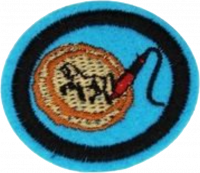Difference between revisions of "AY Honors/Pyrography/Answer Key/pt-br"
(Created page with "{{clear}}") |
(Created page with "</noinclude> <!-- 7. Fazer um desenho para cada uma das áreas abaixo, em qualquer material de sua escolha: -->") |
||
| Line 15: | Line 15: | ||
<!-- 2. Que ferramentas e equipamentos são necessários para a pirografia? --> | <!-- 2. Que ferramentas e equipamentos são necessários para a pirografia? --> | ||
| − | + | {{clear}} | |
| − | |||
| − | |||
| − | |||
| − | |||
| − | |||
| − | |||
| − | |||
| − | |||
| − | + | <noinclude></noinclude> | |
| − | <noinclude | ||
| − | |||
{{CloseReq}} <!-- 2 --> | {{CloseReq}} <!-- 2 --> | ||
{{ansreq|page={{#titleparts:{{PAGENAME}}|2|1}}|num=3}} | {{ansreq|page={{#titleparts:{{PAGENAME}}|2|1}}|num=3}} | ||
| − | <noinclude> | + | <noinclude></noinclude> |
| − | </noinclude> | + | <!-- 3. Descrever, passo a passo, os procedimentos adequados para trabalhos em pirografia. --> |
| − | <!-- 3. | ||
| − | |||
| − | + | {{clear}} | |
| − | |||
| − | |||
| − | |||
| − | |||
| − | |||
| − | |||
| − | |||
<div lang="en" dir="ltr" class="mw-content-ltr"> | <div lang="en" dir="ltr" class="mw-content-ltr"> | ||
| Line 85: | Line 66: | ||
{{CloseReq}} <!-- 5 --> | {{CloseReq}} <!-- 5 --> | ||
{{ansreq|page={{#titleparts:{{PAGENAME}}|2|1}}|num=6}} | {{ansreq|page={{#titleparts:{{PAGENAME}}|2|1}}|num=6}} | ||
| − | <noinclude> | + | <noinclude></noinclude> |
| − | </noinclude> | + | <!-- 6. Que cuidados e precauções devem ser tomados ao trabalhar com pirografia? --> |
| − | <!-- 6. | ||
| − | |||
| − | + | {{clear}} | |
| − | |||
| − | |||
| − | |||
| − | |||
| − | |||
| − | |||
| − | |||
| − | |||
| − | + | <noinclude></noinclude> | |
| − | <noinclude | ||
| − | |||
{{CloseReq}} <!-- 6 --> | {{CloseReq}} <!-- 6 --> | ||
{{ansreq|page={{#titleparts:{{PAGENAME}}|2|1}}|num=7}} | {{ansreq|page={{#titleparts:{{PAGENAME}}|2|1}}|num=7}} | ||
| − | <noinclude> | + | <noinclude></noinclude> |
| − | </noinclude> | + | <!-- 7. Fazer um desenho para cada uma das áreas abaixo, em qualquer material de sua escolha: --> |
| − | <!-- 7. | ||
| − | |||
| − | + | {{clear}} | |
| − | |||
| − | |||
| − | + | <noinclude></noinclude> | |
| − | <noinclude | ||
| − | |||
{{ansreq|page={{#titleparts:{{PAGENAME}}|2|1}}|num=7a}} <!--T:8--> | {{ansreq|page={{#titleparts:{{PAGENAME}}|2|1}}|num=7a}} <!--T:8--> | ||
<noinclude><div lang="en" dir="ltr" class="mw-content-ltr"> | <noinclude><div lang="en" dir="ltr" class="mw-content-ltr"> | ||
Revision as of 00:26, 29 May 2021
Nível de habilidade
2
Ano
2012
Version
05.11.2024
Autoridade de aprovação
Divisão Sul Americana
1
2
3
4
Although wood is the most popular venue, pyrography is not limited to burning on wood. Leather, paper, gourds, bark, and nuts are among the materials you can transform with pyrography. Each offers its own advantages and challenges. Many woods can be burned, but some are more suited to pyrography than others.
5
The temperature setting that you choose for each stroke is a very important element. Low temperature settings create pale tonal value burns. As you raise the temperatur, your strokes take on a darker tonal value.
Each wood burns at a different rate and you will need to adjust your heat settings to accommodate your specific project. Poplar burns quickly. If you have a setting range of 1 through 10, poplar will show pale values as low as 2 and black toned burns as you near 4. Birch burns from a pale value around a 3 and does not reach the black tones until 7 to 8.
Practice on the material that you will be burning on to make sure you use the appropriate temperature.
6
7
7a
7b
7c



